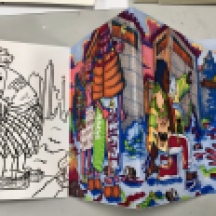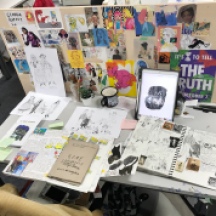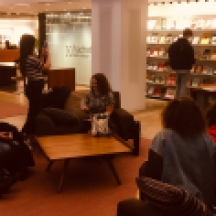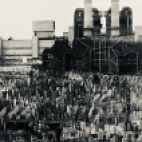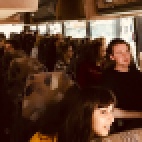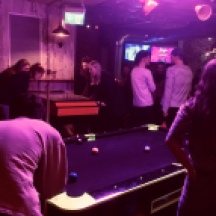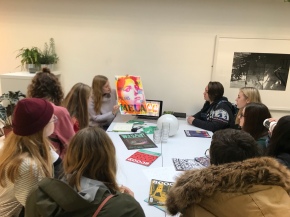The final project of the autumn term for 2nd year students is called ‘The Edge’. This theme based project deviates a little from the more formally context driven briefs of the 1st semester. The intention is to encourage students to take risks and push the boundaries of their illustrative output. It’s a great project. Here is a sample of some of that work. Apologies but it was not possible to credit individual students…
Final New York 2019 Post….
More images from This week’s amazing Falmouth Illustration New York study trip. Visits today include Debut Art, Second Marriage, BUST magazine, The Wall Street Journal, Harper Collins, Bernstein & Andriulli and Vault 49
This will be the final posting on this blog as we shift our social media activity over to Instagram. Many thanks for the support over the last 6 years and make sure that you follow the Falmouth Illustration Instagram feeds as they come on line in the near future. The 3rd year Instagram page is already up and running and can be found at falmouth.illustration on Instagram
Falmouth Illustration in New York: Days 1 & 2
Days one and two in The Big Apple have gone well for our Falmouth Illustration Students with the visits kicking off on Monday morning with a visit to MB artists. MB artists represents over 62 children’s book illustrators from around the world and represent collection of highly-regarded artists.
Following on from that students visited Hearst Magazines. Hearst Magazines is one of the world’s largest publishers of monthly magazines, with 25 U.S. titles and over 300 international editions. Hearst Magazines also publishes 19 magazines in the United Kingdom through its wholly owned subsidiary, Hearst Magazines UK And so was a prime visit to secure for our editorial leaning students.
In the afternoon a number of students visited Buzzfeed. BuzzFeed, Inc. is an American internet an digital media news and entertainment company.
The final visit was to Dragon Rouge. Dragon Rouge is an award-winning global creative agency with offices in Paris, London, Hamburg , Warsaw, Shanghai, Singapore, Sao Paulo and New York. Feedback on these visits and photos will be posted on these visits when it comes in from students.
Day two began with visits to two successful illustration agents. Falmouth has had a long standing connection with Mendola Artists. Having seen them for many years on the New York trip. They currently represent former Falmouth graduate Rachel Saunders.
The second visit was to Painted Words, an artist/ literary agency dedicated to bringing unique voices in children’s books to the foreground. They develop author-illustrators for the children’s publishing marketplace, nurturing their talents into creative projects across the media spectrum. Their goal is to provide the utmost in representation for illustrators and authors while placing a unique emphasis on developing characters, books, and licensed properties.
The third visit was to the New York Times. The New York Times has a worldwide influence and readership. Founded in 1851, the paper has won numerous awards for its journalism more than any other newspaper. It also has commissioned a number of Falmouth Students in recent years, notably Tom Paterson in 2018 who had to deliver a commission during the study trip.
The final visit was to Littlebrown Publishing (part of the Hachette Group). About 12 students met at the Starbucks close to the Neuberger Bergman Skyscraper in Midtown Manhattan. Art director Christina Quintero took us up to the Littlebrown offices afetrewhich four artdirectors spent over an hour and a half looking through the students portfolios. Really useful feedback came from these conversations. Notably Christina said how graphic novels and comics have become very popular with young audiences in the US and they are commissioning more and more in this area. The popularity of hand rendered type was also referred to on numerous occasions. Many thanks to Christina and her fellow art directors for such a great visit. Likewise to those involved in the earlier visits. Again I will post photos of those visits as soon as I have them.
Falmouth Illustration: NEW YORK 2019
After a few stressful moments (well an hour and a half!) waiting for the coach at Woodlane on Sunday morning we arrived at JFK New York late afternoon on Sunday. It was of course a tiring flight but worth it once we saw the Manhattan skyline as we neared the City.
The visits this year are as broad and diverse as usual. The students have done a great job in researching and securing in the region of 25 -30 visits to some of the top companies in New York with more visits coming in at the time of writing.
these visits include amongst others; MB artists, Hearst Magazines, Buzzfeed, Dragon Rouge, Mendoza & Rapp, The New York Times, Littlebrown Books, Painted Words, Pearl Fisher, 3×3 Magazine, Mucca, Penguin Books, Debut Art, BUST Magazine, The Wall Street Journal, Vault 49, Second Marriage, Harper Collins, Bernstein & Andriulli, Hemispheres, Sterling Publishing, VICE and more….
I hope to be posting throughout the week and once photos start to come through from the visits….
This Much I Know: Insights from India on becoming a successful visual artist
Based on conversations with visual artists during visits to three Mumbai studios, in January this year. An exhibition will also be taking place in the Woodlane library of works by Indian illustrators during February.
Written by Helen Trevaskis, 2nd Year Illustration
Mumbai is India’s biggest city and the fourth biggest city in the world. As well as being home to Bollywood, one of India’s most famous exports, the mega-city is a hub for visual communications in India, due to the head quarters of most big local and international advertising agencies being located there. Bombay, as most locals still call it, has a growing illustration scene although there are no pure illustration courses in India, and freelancers and studio employees must typically retain a higher degree of flexibility to thrive commercially than visual artists in the UK.
Lokesh Karekar, Founder Locopopo
Lokesh Karekar studied at Sir JJ School of Art, Mumbai, and worked as a visual artist and art director before establishing his own studio Locopopo aged 29. Despite launching one of the first illustration websites in India, he prefers the title visual artist; ‘illustrator’ is too narrow to encompass all his interests. Locopopo works for international and Indian brands, and acts as a platform for Lokesh’s many personal projects. In 2010 Lokesh’s work appeared alongside over 200 artists from around the world in The Ark, an illustrated animal ‘bible’ raising awareness of soon-to-be extinct species. In 2014 Forbes India recognised his rising influence listing him in their 30 under 30.
Sameer Kulavoor established the studio Bombay Duck Designs which works at the intersection between art, illustration and design. While Sameer is increasingly better known as a painter, like Lokesh who he was class mates with at Sir JJ, he remains one of the best-known commercial illustrators in India. Work that helped him achieve this includes his illustrations for The Ghoda Cycle Project – a collaboration with the clothing brand Paul Smith, and Blued – a self published book on the many uses of taad-patri (an inexpensive bright blue tarpaulin found all over India) by resourceful fellow Indians. Vogue India recently listed him as a mover and shaker in the art world in their 40 under 40 list.
Kahani Designworks was set up by two Mumbai graphic designers who met while studying at University of the Arts London (UAL). Kahani roughly translates as ‘story’ and the studio roots all its work – much of which includes illustration, in a belief that without a narrative there is no meaningful visual communication. Its work divides between work for commercial brands, work for arts organisations and with artists, and its own project and product line Storycity. Storycity is a set of illustrated and annotated maps of Mumbai designed to help locals and foreigners engage in new ways with the megacity, through carefully researched stories that explore its relationships with the sea, nature, history, design and more. Aditya Palsule, Principal and husband of Founder and Principal Ruchita Madhok, was interviewed for this article.
Q: How does India influence your work and the work of your studio?
LK: My work is very much influenced by India. I like to have a modern Indian take so it’s not purely tribal or folk. I also take inspirations from around my world, from Bombay, or Indian styles, which I then try to fine-tune. There are many clients now who want a global style that also keeps an Indian-ness to it.
SK: It happens naturally it’s not a conscious decision. It’s my surroundings, where I am and if I was not here, then I’d be influenced by somewhere else.
Blued (below) especially you can call it Indian.

The book ‘Blued’ by Sameer Kulavoor tells of the many inventive uses of taad-patri (tarpaulin) by Indians
The book happened because I was on the main highway of Bombay at 3am and next to me I saw this huge blue tarpaulined thing. When it over took us I could see it was a helicopter – imagine that! Huge. The sheet of blue was endless. And then I was like, ‘Shit! This needs to be done’. I haven’t done the helicopter drawing but that was how Blued came about. A lot of people say to me, ‘Oh you’re making a project out of poverty’ but it’s not about poverty or economic backwardness.
The use of this blue tarpaulin happens because in India we need to make the most of everything. We don’t have the budgets to repair a roof so we use this material – the quick fix. This use speaks about a lot of other things: how we live, how we think, how we create. There’s a beauty beyond the way it looks and that is inspiring, it’s an amazing display of creativity.
But in the last five-10 years honestly this whole thing of Indian style and Western it’s blurred. Western artists are using Eastern motifs – there’s a lot of cross-pollination.
AP: Ruchita set up Kahani back in 2012 when we returned from working in London. We felt a lot of Indian design then was kitschy and surface led. We believe you need a solid narrative that links all your ideas together. And there is a lot to be gained by looking through local stories, history, local context, ideas that come from local languages – our work is a mix of all those things.
Q: Where do personal and studio projects fit alongside commercial briefs?
LK: I keep telling everyone in the studio, keep doing your own stuff! Create your own bank of ideas, so you can use those ideas in commercial work. Keep evolving them and keep a bank ready. Many works I did for illustration projects were actually from sketches I did. For example one project I did for Taj Hotels, there was a lot of my personal styles that fed into it.
I push everyone in the studio to have their personal taste. Not to do only commercial work. It’s very important to develop what’s very special to you, that comes from within. Unless you are a good artist in your soul you can’t do the commercial work, you can’t express yourself more freely.
It does become slightly difficult to manage both but sometimes the commercial helps my personal and sometimes personal helps my commercial and it’s also an outlet for me to express my own thoughts, my personal stuff.
SK: I started with extremely commercial work. I come from a very basic family and my first intent was to make money. But I always had this thing that I wanted to put out my own work and the form has been evolving over the years. Three-four years ago I started doing lots of paintings. Before it was outlines, typical illustration. Then I started doing more of gouache and painting. It started during a trip to South East Asia I had 40 days off and was making a lot of paintings… And that process was very liberating.
I stopped enjoying these projects where we are given a brief it felt limiting, I had more to say, I wanted to do things very freely. That’s the reason why I’m now painting.

Storycity started as a studio project at Kahani Designworks – each map explores Mumbai through stories
AP: Storycity (above) started as a studio project. We thought it would be one publication and see how it goes but we just had more ideas as we went along.
We were thinking with Storycity how do we engage with the city because it’s such a creative cosmopolitan place. We didn’t want to just do a guide, there are 100s of those. We wanted to see how to something special, visually interesting, with a really well researched set of ideas – so it’s a map of stories. We were particularly looking at links to the sea. A lot of locals don’t realise that the biggest open space Bombay has is the sea – they treat it very badly. Bombay has been carved from the sea. In a way we’re trying to go back to that link, it exists because of the sea and its relationship to where it is and what are all the interesting stories we can find.
Storycity is good to have. It helps keep our team in an experimental mode – it’s kind of our lab! It’s a way to try production techniques, for the team to engage with content better, understand where to find information not just via a Google search. It’s a way of training our team too. And we sell it – if you have an idea it’s going to die if it’s not sustainable! It’s important to see if it can be a viable product.
Q: When a brief comes into the studio, where do you start?
LK: I try to begin from the brief itself. What is the requirement? How can we make it look interesting? I don’t always start from sketching. I often start from giving it thought, what different thing can we do in this brief because every brief will have restrictions. So we brainstorm first…
You need someone to open their mind to work on a project. Execution we all can manage, before that you need to open your mind. Don’t be structured on how to do a project, ‘This should be the process because that’s what we did for the last project’; doing something different for each project automatically brings excitement. We try to do something different so it becomes distinct.
But many times because they (studio team) are very focused on one project it can be hard to get them out of that zone and into something different. A girl here was working on a bed linen brand for one month and then I put her on a kids’ brand and she couldn’t get it! So I had to tell her to go out and go see all the kiddie things, how people approach different kids brands, where kids go, so sometimes you also have to make space to allow people to open their minds.
AP: We are very interested to understand what is the deeper story behind a brief. It’s not just about creating a pretty picture or a fancy logo. If something doesn’t have a narrative it is harder for people to trust it. We always struggle to start off with something where there’s no story, so we try to find a story and then everything comes from there.
Q: Where does your inspiration come from?
LK: So it mostly comes from travelling because then my mind is very relaxed and I can draw. Last year there was an art biennale in Kochi. I saw many things, many art projects. Inspired from that trip I’ve done a set of six cards – it looks abstract, some moments are from that trip some are abstract. It was really interesting to me. I’ve produced 100 copies to sell at design stores.
In the studio on a daily schedule it’s so tight I never get good time for me. Saturdays and Sundays I sketch. I start by looking at the objects around me and also eliminating some objects out and that inspires me a lot.
SK: I’m very observant I think. All my work draws heavily from observation, absorbing something and it coming out in a different form – I’m sensitive to what I see. 80% of the stuff that finally goes out starts in a sketchbook or as a small drawing somewhere. And you don’t even know when you’re doing it that this is going to become something! You don’t want to put that pressure on yourself to think about the next project. What really helps is revisiting your sketchbooks now and then.
Also, taking sabbaticals – I spend 50 days a year out of my country, since 2008. After coming to London in 2008 I started making zines. If I get stagnant it works to leave and come back: in a different place a lot of knew things open up. Travelling is probably, a fancy word it’s about getting uncomfortable. I’m fighting stagnancy all the time. The minute I feel it, it bothers me. Others are OK with routine, it’s very personal.
Q: Is it important for an illustrator to find their style, their voice?
LK: I tell people maybe don’t arrive at a style very soon! Right now all the students are very much in a hurry to have their own style. Because style is something that comes from years and years of practise, and drawing and feeling because I see people who pass out of college and have a very fixed idea of style and they can’t change it. This is what I will do for the rest of my life! This makes it very confusing for them to take a different approach in future. Have an open mind before arriving at style. People are very much in a hurry and that’s not the way to work. You can change your style you can do whatever you want. No one restricts you.
SK: That word ‘style’ I find a little strange. It keeps evolving and for me content comes before style – what do I want to tell, what am I doing, then what’s the best way to do it? Everyone is running after wanting to have a style. I don’t approach it like that. Because I know I get bored of doing one kind of thing.
When the Paul Smith four T-shirt collaboration happened – that project got really popular because of the collaboration and got spread on social media – and then for the next one year people kept coming to me saying, ‘Hey I want you to illustrate a bag but in that style’. So that style became like a cosmetic thing that I would have to use whatever I make in life thereon. So I stopped doing that. I did it for six months then I thought, ‘No more felt tip pens!’ Even if it was tough, I just couldn’t keep doing that.
I don’t know if they’re stuck, if it’s intentional or that’s the only way some people want to work. And it’s a choice I’m not saying it’s a bad thing. I just don’t think like that. It’s also a good thing, it’s easier for people to hire you if you’re known for a style, but I’m not driven by that.
AP: As an illustrator it’s important to have a voice it’s part of the reason why someone would come to you – they want that voice and style on a project. They like the way you see the world outside, you have something they understand but can’t execute.
But in the studio I wouldn’t say we have a style, there’s definitely an approach to how we look at things but we don’t want to limit ourselves to a particular style. People might approach us to work on something we’ve never worked on before – that happens a lot. Clients are savvy they know they’re hiring the designer or studio for the input they can’t provide, the content, not to replicate a style. Everyone is on-line and looking at different things, trends change quickly and clients understand that.
Q: What other advice do you have for students entering the world of work?
LK: Sometimes it will be better to say, ‘No’. five-six years ago I did a project for a pre-school brand. Then we got another and another and it was all kids’ illustration we were doing in that particular year. So then I didn’t want to do it! It can become your identity and so that kind of work keeps approaching you. It’s very important to break that, saying no to projects which you’ve already done or are very similar. Clients from that same industry approach you because a brand becomes successful and their competitors approach you and ask for it in a similar manner. But you want to do it totally different and it’s hard to tell the client they need something different! It’s hard to get him to understand; you want to given them a direction that’s only for them.
SK: There are two kinds of illustrators in India – the urban kid who is exposed to the internet and a lot of other things and there’s the folk artists holding on to traditions in the villages and there the talent is being passed to one generation from the next – you can see that in Tara books (see below). They are different from each other.

A visual ode to trees and example of illustration inspired by tribal artistic traditions, published by Tara books
The new kid who’s on the internet and social media there are lots of influences… and I just feel that the influence of social media is killing some of the need for originality and the need to work hard. Every new illustrator’s work I see you know it comes from here or there. It tends to get diluted. And it’s so easy to put out work now. People can just reach out to you and talk. Back then it was a big task to get hold of an art director in an advertising agency. A lot of kids get distracted with this easy way of doing self-promotion. That shouldn’t be the driving force.
AP: When you’re starting out fresh out of university go with the flow, try everything out, don’t box yourself in because you never know where something will lead. Always look at something for the long term prospect – how will this help my career develop not how much will this pay me now. In the UK it’s more specialised – you’re an identity designer, you work on brands, but it’s changing and there’s an advantage to fluidity and so staying flexible and collaborative is the way forward.
And do not do things for free! Don’t let yourself to get exploited.
London Study Trip 2018: final post of the week
So finally, we’ve made it to the end of the week! 23 visits to top art directors, publishers and agents, one hugely informative Illustration Forum later and students and staff can now head back home for a well earned Christmas break.
The final evening involved a few well deserved drinks in the bar of the Generator. Once the disappointment of how bad Nigel’s amateur magic actually was, the students attention turned to the Karaoke, while the tutors beated a hasty retreat…..
The team would like to thank all of the creatives who have generously given their time to talk to us about the work that they do. It has been fantastically useful for our students who now have a much greater insight into the industry that they will be entering in 3 years time. Thanks too to the students who at the end of a long and intense semester conducted themselves really well, asking great questions and for putting up with Nigel’s bad magic tricks and crucially for not forcing the tutors to do the karaoke!
Special thanks go to Tilly and Nick for traipsing around a London to the numerous visits. Also Sarah Hayes for her invaluable help in getting the visits booked. Many thanks also go to Rachel, Anthea and Anna in the Art Admin team for liaising with the tour operator.
Falmouth Illustration London Study Trip: Day 4 (the final visits)
The final day kicked off with Nigel taking a group of students to see Sarah Habershon at The Guardian. Sarah has been championing illustrators for the last 17 years at The Guardian. She is a well known advocate for illustration and was referred to as such by Michael Kirkham in the previous days tal at the City Lit. She spent an hour of her valuable time to explain the process of commissioning an illustrator to our students.her presentation was hugely informative. Thanks to Tom Barwick for organising this visit.
Meanwhile Nick Mott took students to see the well known Children’s Book publisher Usborne. Mary Cartwright spent the best part of an hour discussing the children’s book publishing industry to our students.
Tilly McKerrow took a group to Bernstein & Andriulli for the 2nd visit of the week to this fantastic agency. Thanks once again to the team at B&A for their time. The students really appreciate it.
Debut Art was the next visit for students. Nick took 11 students to see Andrew Coningsby at this important illustration agency. Thanks to Andrew and his team for taking the time to see our students.
Finally Nigel took students for the last of the 23 visits during the week. Carlton Publishing stands out in that it’s range of publications is particularly broad and diverse. It was really exciting to see how they approach the production of a book. They are unashamedly commercial in their intentions but nevertheless produce very high quality books. both Emily and Clare spent around an hour with out students. Their clear passion for working with Illustrators shone through. There description of the Bologna Book Fair has I am sure whetted the students appetite for a visit in the 3rd year of the course.
All that is left of the week now is to relax with a long tall glass of beer and maybe a few ‘magic’ tricks………..
Until next year…..
London Study Trip: Day 3- The Forum
Wednesday was the day of the Illustration Forum at The City Literary Institute but before that, in the morning Tilly took a group of students t see the long established illustration Agency, ‘Folio’ just of the Kingsway near Holborn. Former Falmouth illustration graduate Kim Meech now works as a rep at Folio and met our students for this visit. Folio agency has a long history of representing successful and interesting commercial illustrators. Former Falmouth graduate Illustrator Owen Davey is currently on their books. Folio agents talked to students about freelancing, the role of an agent, different types of commissions, how to put together a commercial portfolio and much more. The advice was invaluable and gave students a real insight into a career in illustration.
While Tilly and the students were at Folio Nigel and Nick met at The City Literary Institute to get ready for the afternoon’s Illustration Forum. The City Lit is a fantastic Adult Education Institution that has been providing learning opportunities for the people of London for many years. It is also the first place that Nigel ever taught and so was something of a trip down memory lane for him. students began filing into the small but atmospheric lecture theatre just before 1pm. Much to Nigel’s relief all three speakers arrived in time for the start of the afternoon.
First to speak was Viviane Schwarz. Viv is an alumni of Falmouth University having studied on both BA and MA courses. Her talk was both hugely entertaining and informative. Her unique take on life shone through and her ability to cut through and communicate to subtle details of life that we often miss was clear. Her development of characters through a joyous engagement with media and the tools that she has developed was fascinating. Her ‘ghost’ installation project caught everybody’s eye.
Second to speak was the inspirational reportage illustrator, Olivier Kugler. Olivier is well known for his work with the Guardian but this is the tip of the ice berg in terms of his career, having worked extensively in the U.S. and also Europe. He is an award winning illustrator whose approach to illustration is founded in a desire to connect with social issues, such as homelessness and more recently the Syrian refugee crisis. His wide ranging talk encompassed his early career working in New York and the influence that his American tutors such as Marshall Arisman had on his work. His more recent work has been based upon his direct experiences of meeting Syrian refugees and telling their stories in a unique a compelling montage of journalism and illustration. We are really looking forward to seeing the outcome of his most recent project to document the UK fishing industry.
Finally the third speaker shone a light on the work of the editorial illustrator. Michael Kirkham had travelled down from Edinburgh for this Forum for which we are extremely grateful. Michael perfectly outlined the process of editorial illustration. He has worked for some of the best known editorial clients including most notably The Guardian and knows a thing or two about the ptressures of working in this sector of the industry. He discussed his approach to the figure and also his focus on searching for personality rather than style within his work. Most tellingly he opened up on the ideas process. His focus is on avoiding searching for an idea but instead champions the notion of just pushing the process of just ‘drawing’ around the core theme of a text. Essentially just keeping the search field for ideas as open for as long as possible before committing to the final concept. Judging by the work that he was showing us he has got the formula just right.. A really great end to to a fantastic afternoon of talks.
London Study Trip: 2018 DAY 2
Day Two of this year’s 1st year Illustration study trip to London began with a trip to see former Falmouth Illustration Graduate, Richard Bravery, who is now a senior cover designer at PenguinBooks. Richard outlined the process of commissioning illustrators for book covers and focussed on the need for the illustrator to contribute in the ideas generation process rather than being simply a technician who applies their style to an idea developed by the design team. It was really refreshing to see how designers still value the skills that illustrators can bring to the table. It was also interesting to hear about his own career path.
Nick Mott took 10 students to see the Ryan Claydon at the Illustration Agency JSR. This was a new visit For the course but proved to be really valuable.
Meanwhile Tilly McKerrow took a group of students to visit the creative agency ‘Lovers’. This is a rally innovative creative agency who really value illustration. Many thanks to Lisa Armstrong for agreeing to see our students.
Hot on the heals of the Penguin visit Nigel rushed over to Somerset House to meet up with 9 students for a meeting Stuart and Amy of the Illustration Agency known as ‘HandsomeFrank’. This relatively young agency is making waves in the industry and it was great to hear about their approach to representing their roster of artists. Stuart and Amy gave the students an hour of their valuable time and delivered huge insights that will prove to be invaluable to them in the future. Thanks to the AOI for their help in organising the fantastic venue.
11 student met Tilly ahead of their meeting with Illustrator PeteFowler at his studio in the east end of London early in the afternoon. Pete has generously offered his time to talk to Falmouth students over the last couple of years. He talked at length about his career, including his work with the ‘Super Furry Animals’ and his current projects. Many thanks to Pete and also Tom Barwick for organising this visit.
Nigel took 4 students on the long track to Stratford to see ArenaIllustrationAgency. Tamlyn Francis and Caroline Thomson are long standing friends of the course and have been seeing students from Falmouth on this study visit for many years. Every year they give a great presentation of what they do as agents discussing individual projects that their artists have been recently involved in. This is hugely inspirational for students making them aware of where Illustration as an industry can take them.
At the same time Nick was taking a group to see Creative consultancy ‘POCKO’. POCKO are an artist Agency and creative consultancy whose services include brand activation, Illustration, animation, and photography. Their objective is to curate and create innovative content through collaboration. They represent the trend towards multidisciplinary within the visual communication industry.
Finally, Nigel took a group of students to see Art Director/designer Gary Cochran at The Economist/1843. These two magazines epitomise what editorial illustration is about and it was fascinating to hear Gary talk about the process of commissioning illustrators and why he is so keen on illustrators as ideas generators. Gary’ significant experience within the field of magazine design was of huge value to the students that were on the visit. It was also great to be given a tour of the Economist offices and to see the amazing roof terrace views.
London Study Visit: Monday’s Visits
The day kicked off with a great visit to Thames & Hudson. Art Directors Anna Ridley and Aaron Hayden spent over an hour talking to students about the process of putting a high quality Children’s Picture Book together. Their talk was hugely informative. Thames & Hudson are fairly new to Young Audience Picture Books but have developed an enviable reputation. Aaron particularly focussed on illustrators needing to have a good knowledge of reprographic processes.
Nick Mott took 5 students to visit Jo Cochran at The Guardian/Observer. The Guardian and Observer have always championed Illustration and it was really refreshing to hear Jo be so positive with students, with possible connections through projects in the future. It was interesting that she chose one our most successful recent graduates, Harriet Lee Merrion to use as a case study when explaining the editorial process to students.
Lipstick of London is an international Illustration Agency that connects a select range of illustrators to clients in a large range of fields such as fashion, advertising, live drawing, and animation. Tilly took 6 students to see this Agency in the morning. Marie-Claire Westover was really generous with her time, sharing her insights into freelance illustration including how to approach self promotion, current trends, working with different clients and the benefits of having an agent.
Because there have been so many visits made this year it has been impossible for tutors to attend every visit. the trip to Scriberia as a result was student led. Scriberia are an slightly unusual left field visit for our students. Their focus in on providing ‘live scribing’ services to industry whether visually recording a conference event or visual problem solving sessions. This is really relevant to our students and by all accounts the visit was a great success. Thanks to the students for managing this visit on their own….
Nick took 8 students to visit the well known children’s book publisher, Simon & Schuster. Art Director Jane Buckley was able to provide really useful insight into the process of putting a Picture Book together.
In the afternoon Nigel took 8 students to see his former agent Bernstein & Andriulli at Borough Market. After a minor panic trying to find their offices, Matthew, Karrie and Sam spent an hour passing on their in-depth knowledge of the industry to students. They talked at length about the need to maintain a level of professionalism when dealing with clients in order to build your reputation as an illustrator that can ‘deliver’. They cited former Falmouth Graduate and B&A artist, David Dorian as the perfect example of this philosophy. Many thanks to Matthew, Sam and Karrie who have also agreed to see a 2nd group of Falmouth Students on Thursday (if they have recovered from their Xmas party!)
Hachette were the next visit of the day. Tilly took a group of students to see art director Sophie Stericker who spent a good amount of time talking about how they work with illustrators and also aoutlined the Carmelite Picture Book prize which Falmouth alumni Riki Sekiguchi won last year.
Nick then travelled over to the other side of the city with a group of 14 students to visit Laura Bird at Egmont. Egmont are a long-standing contact who have provided great insight into the business of Children’s Picture Book publishing. this year was no exception.
Finally at the end of the day Nigel took a group students to see Sara Marafini at Hodder. Hodder produce high quality adult fiction and non fiction books,. The art directors that we saw predominantly focussed on fiction covers. Really interesting discussions about the relationship between text and image and how Illustration functions on a cover were followed by some great questions from the students.
Many thanks to all the art directors and designers involved in today’s visits…..














